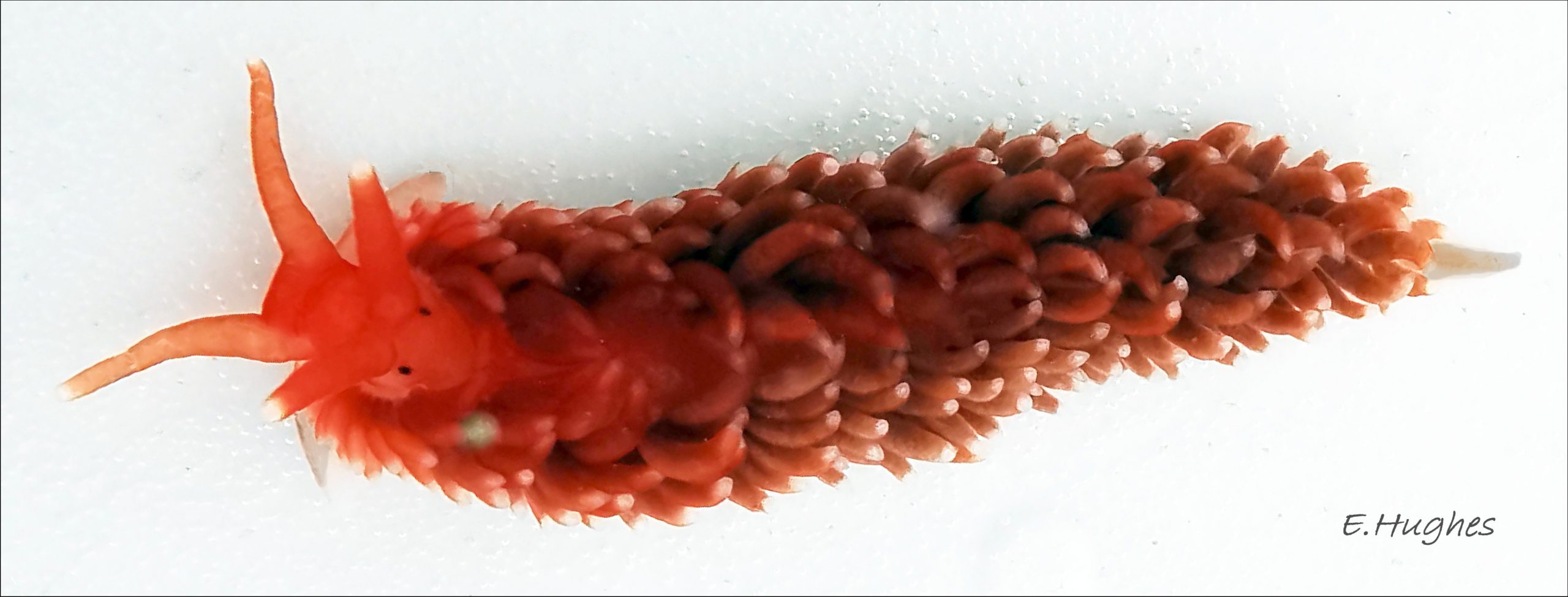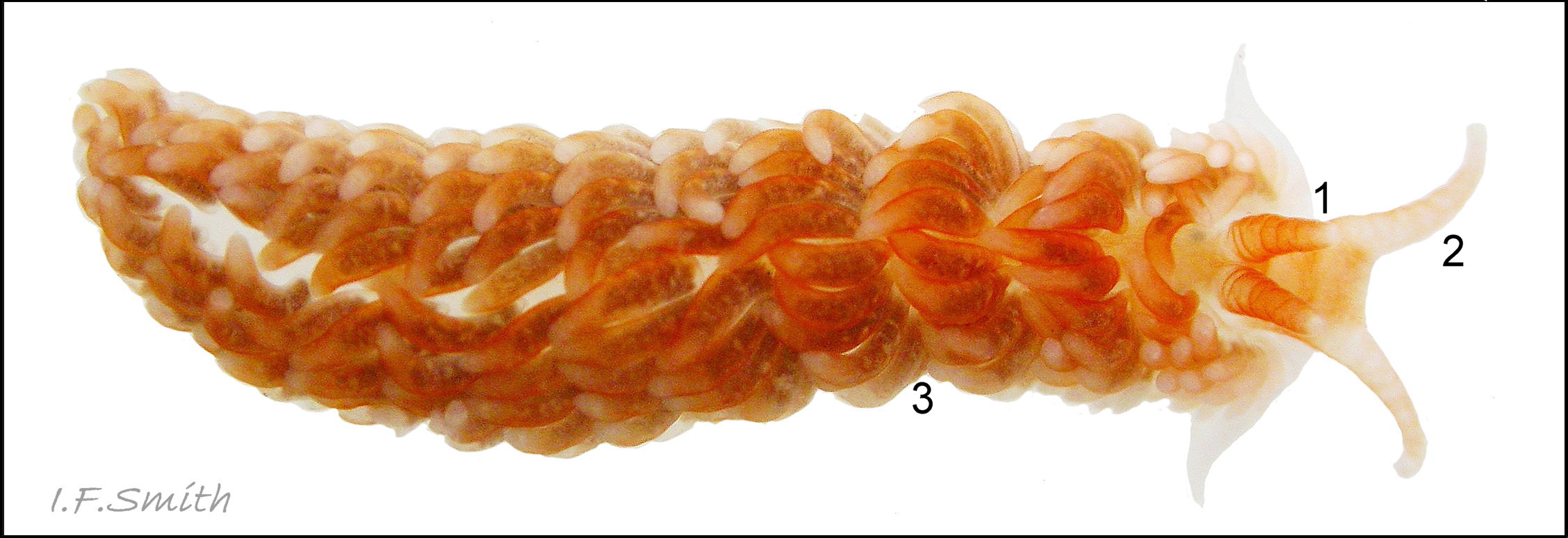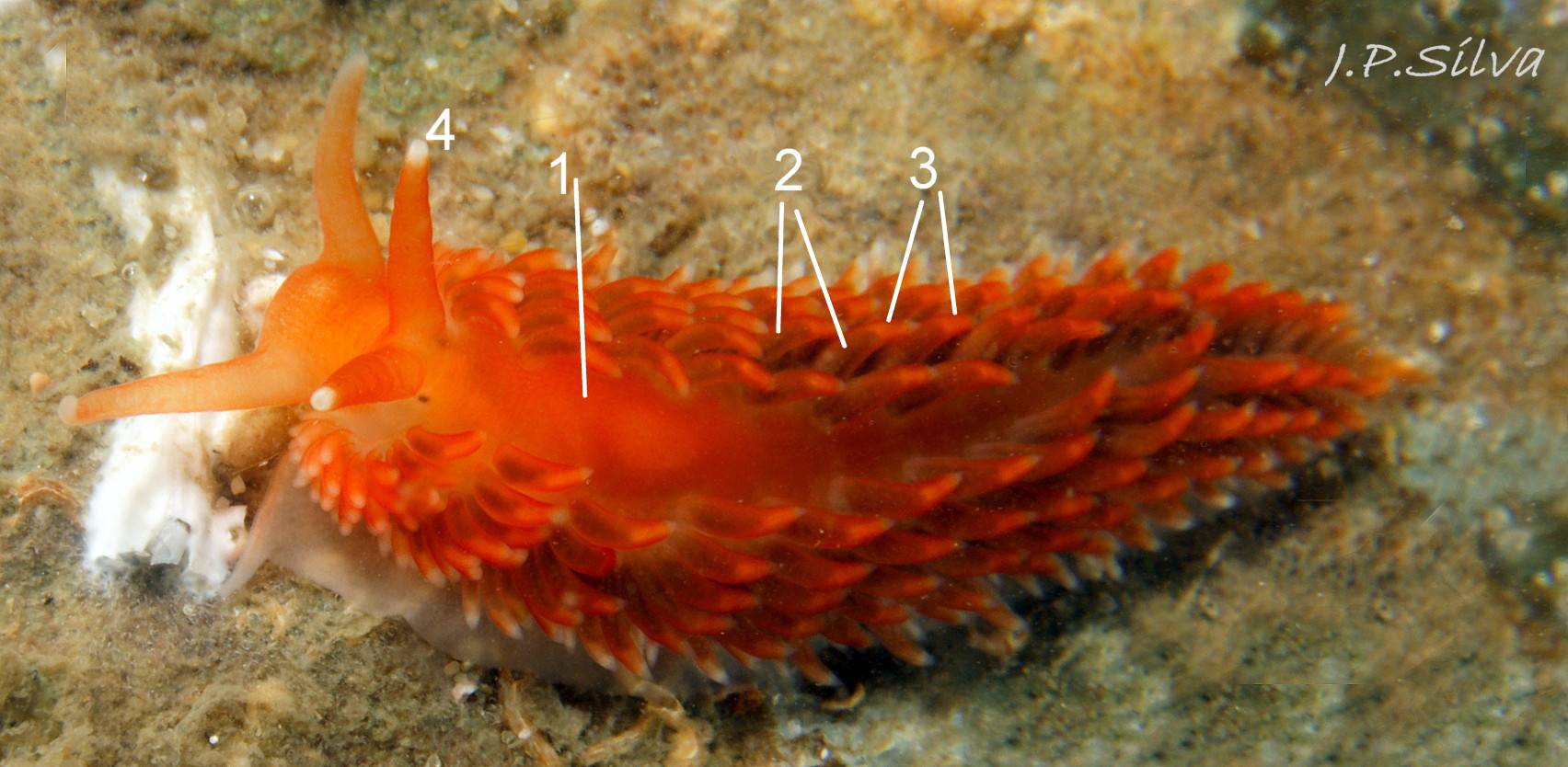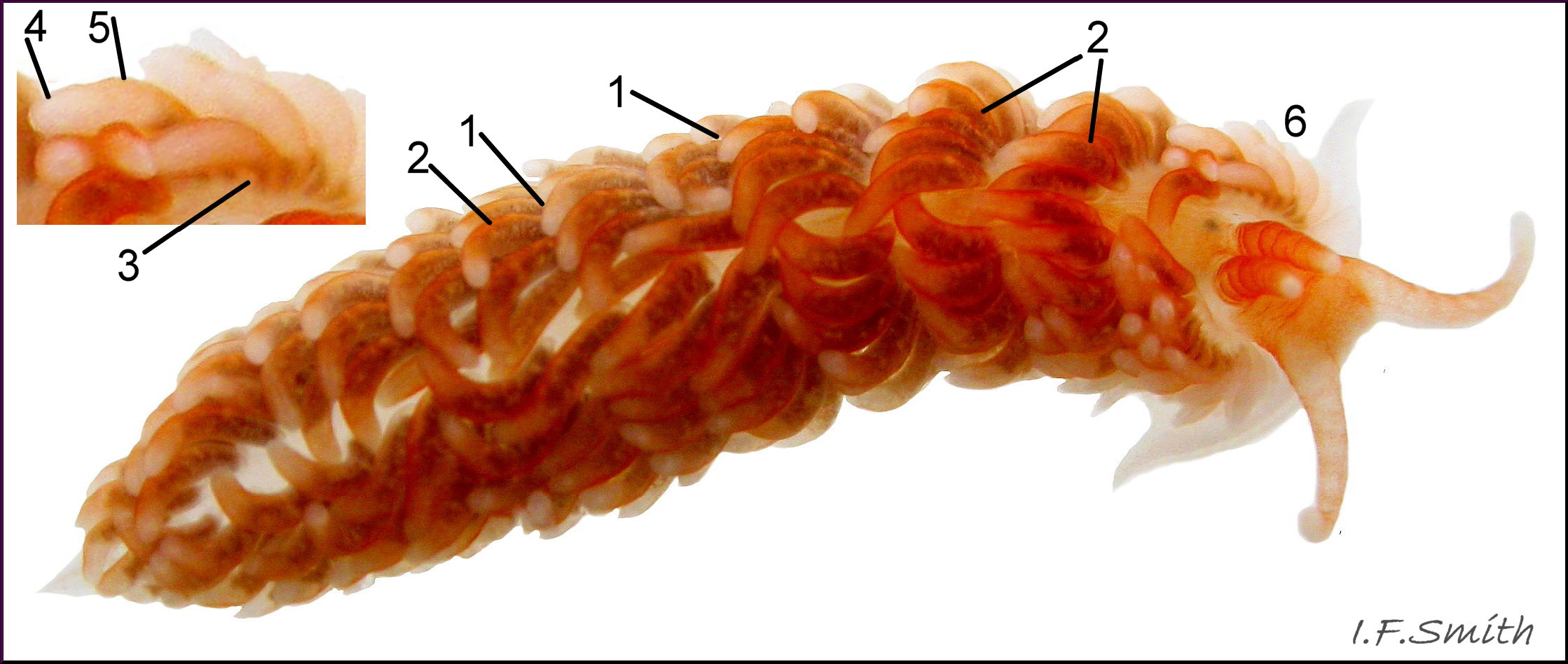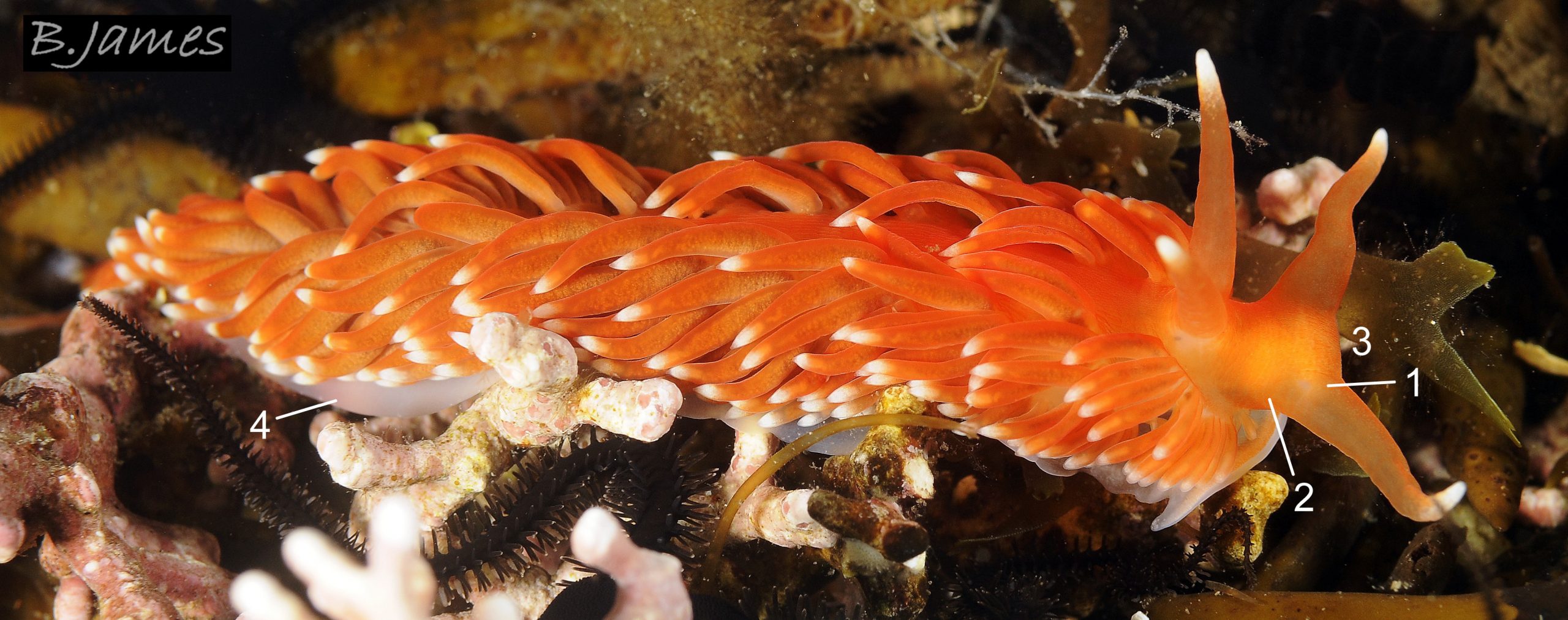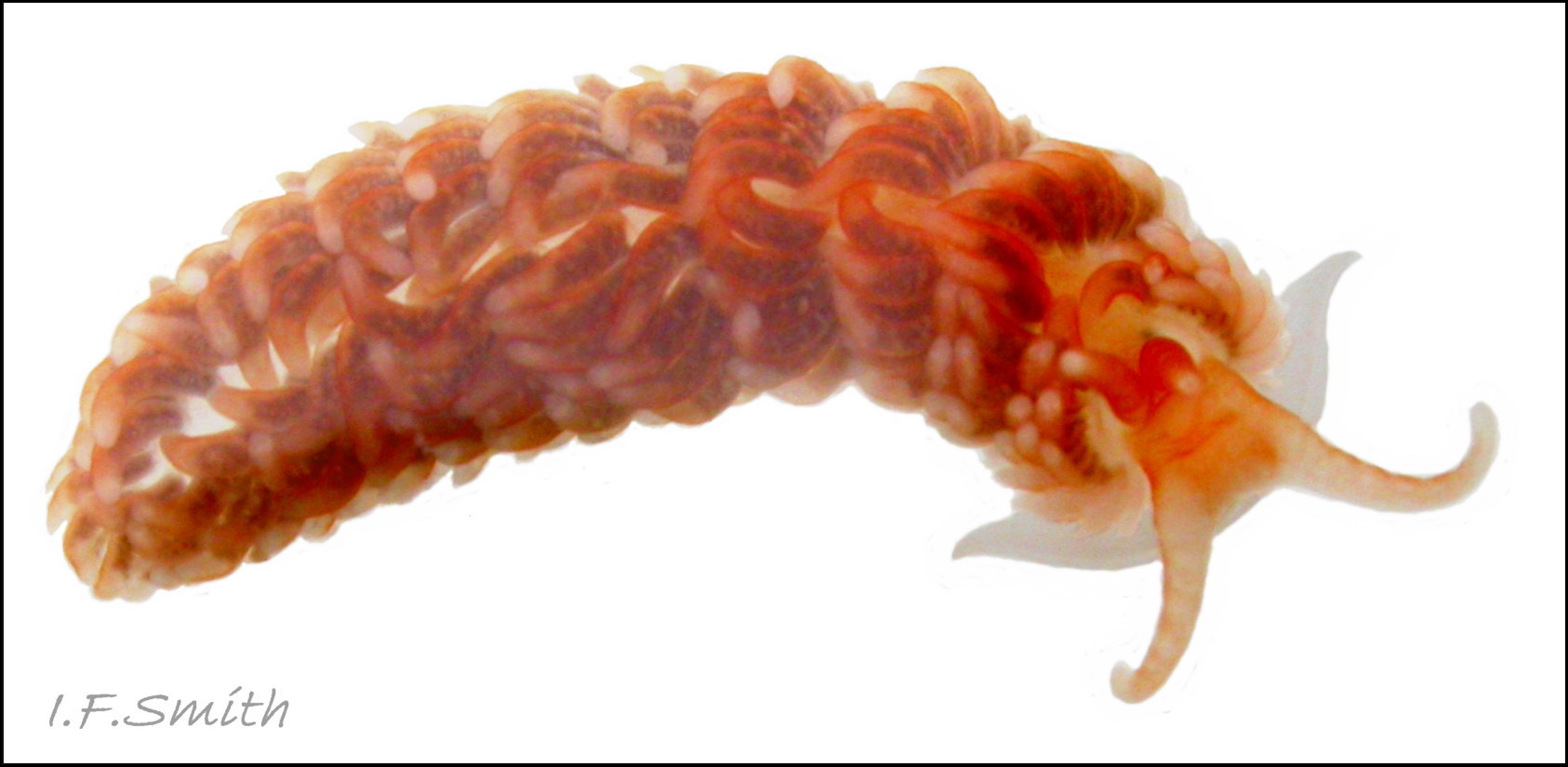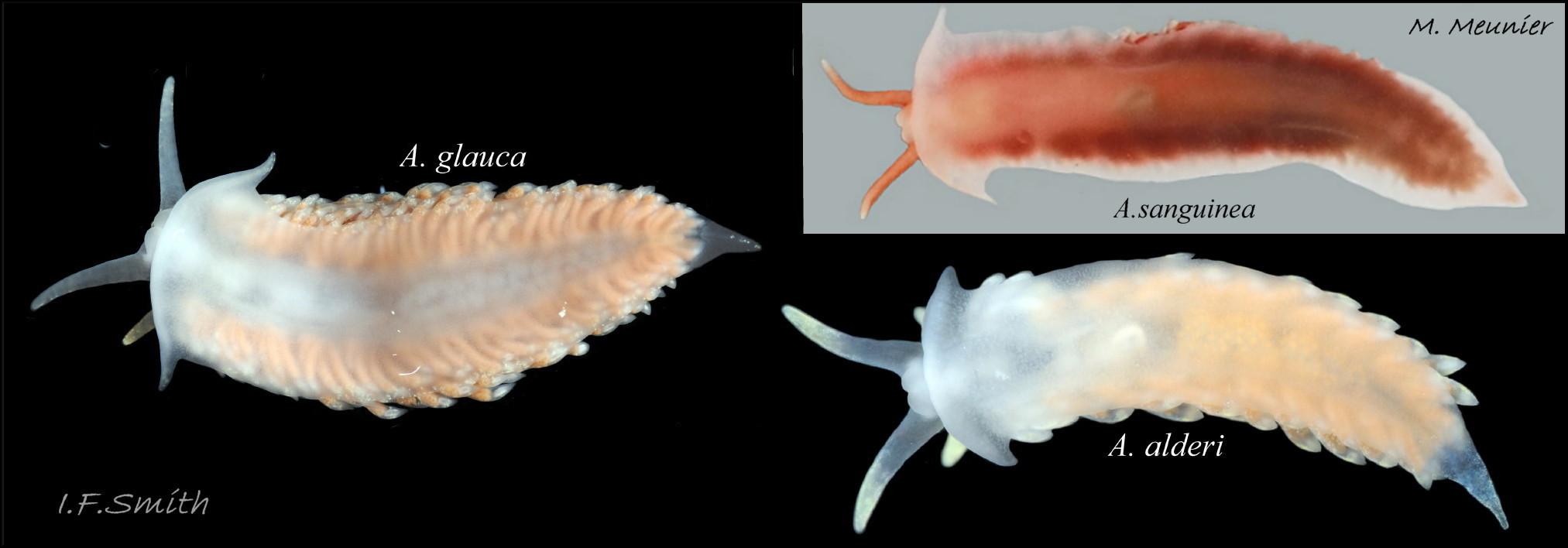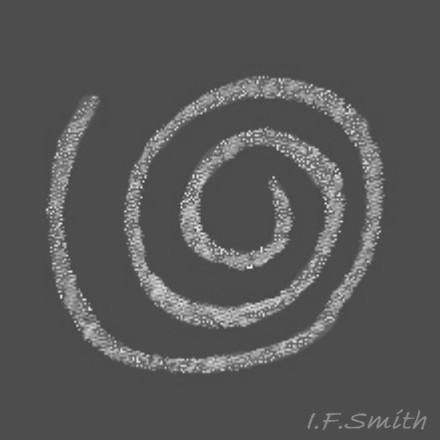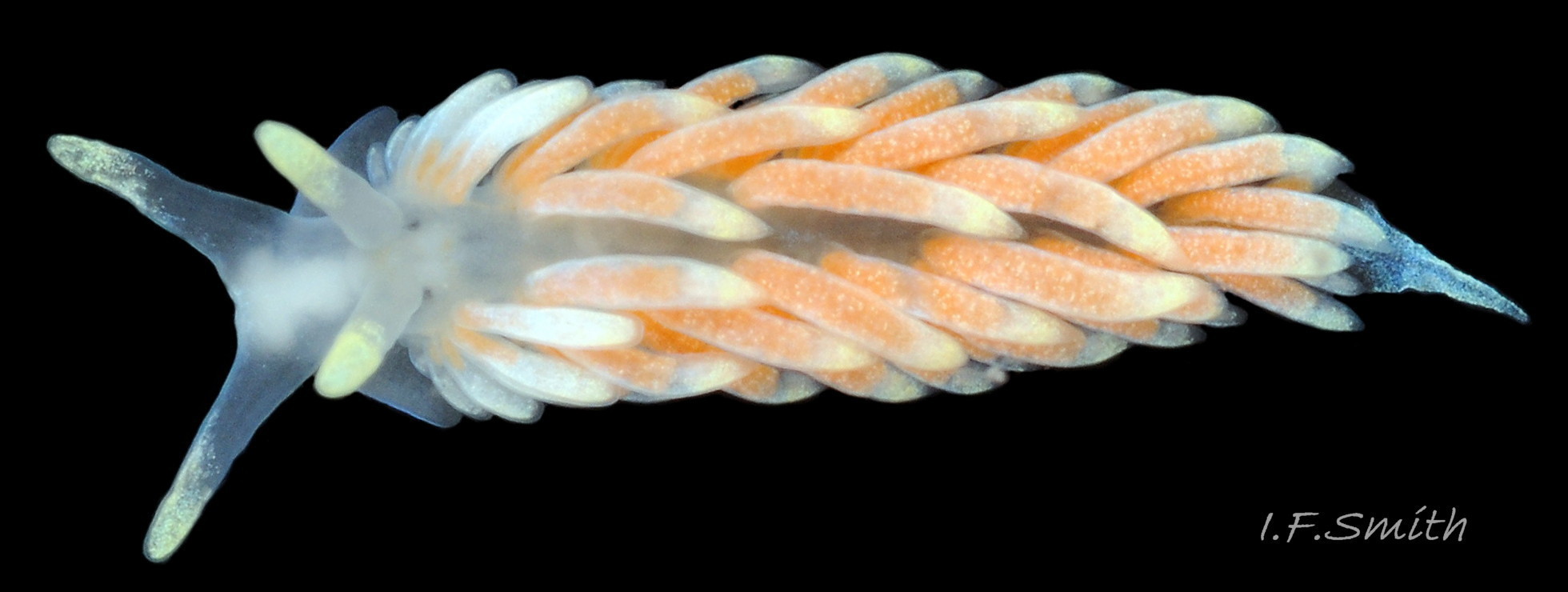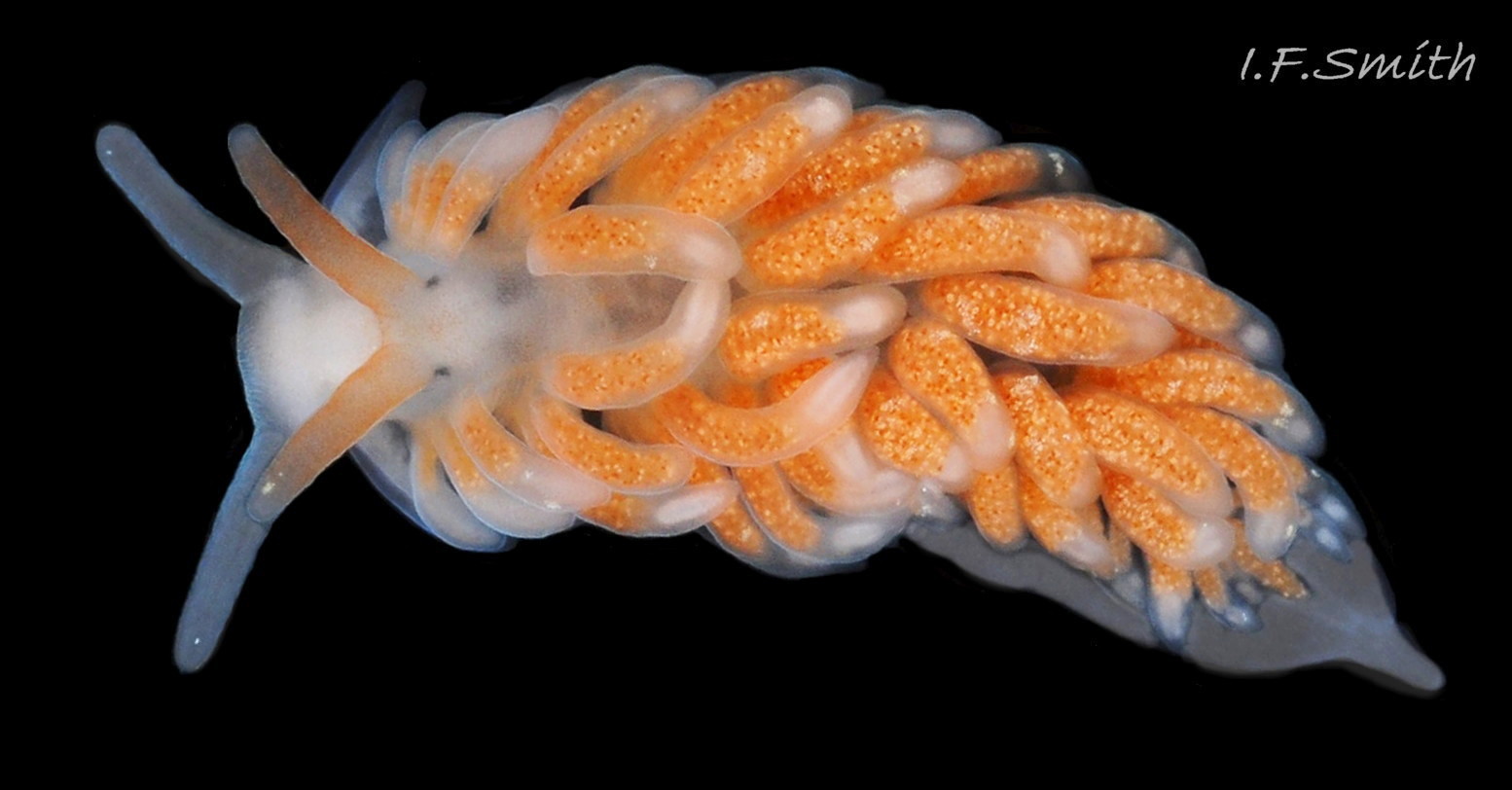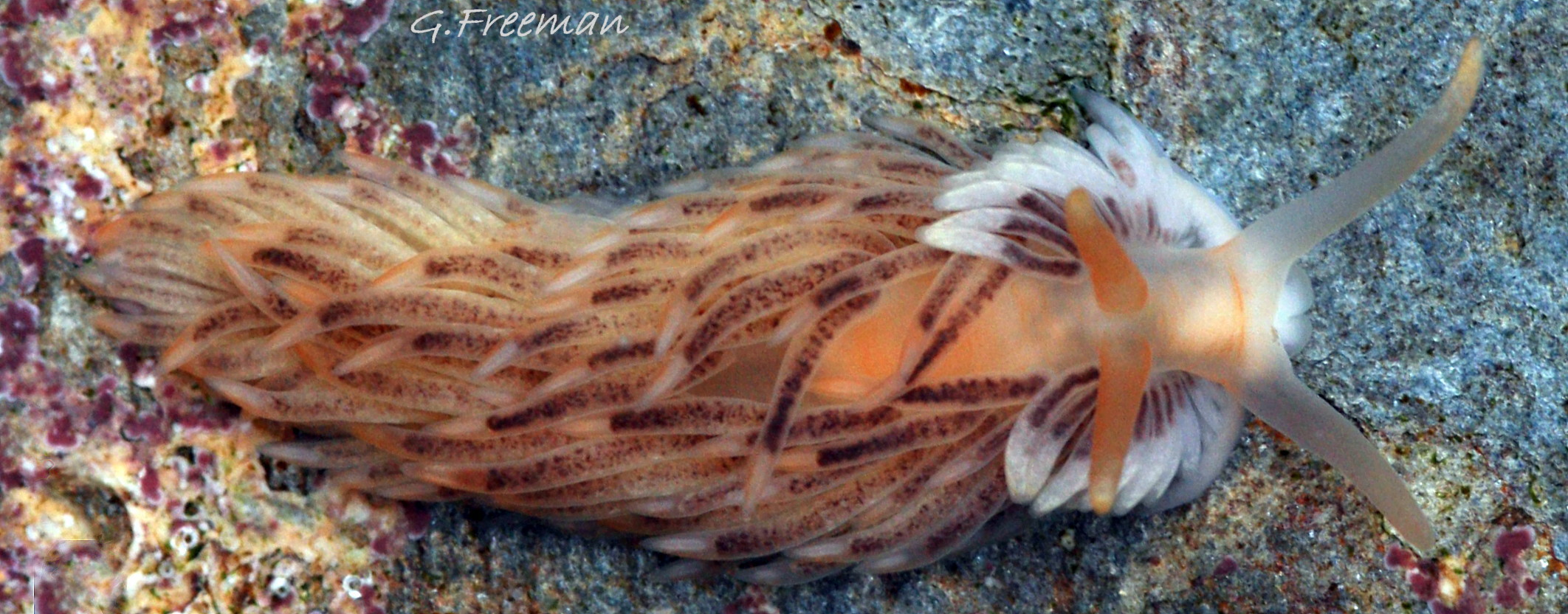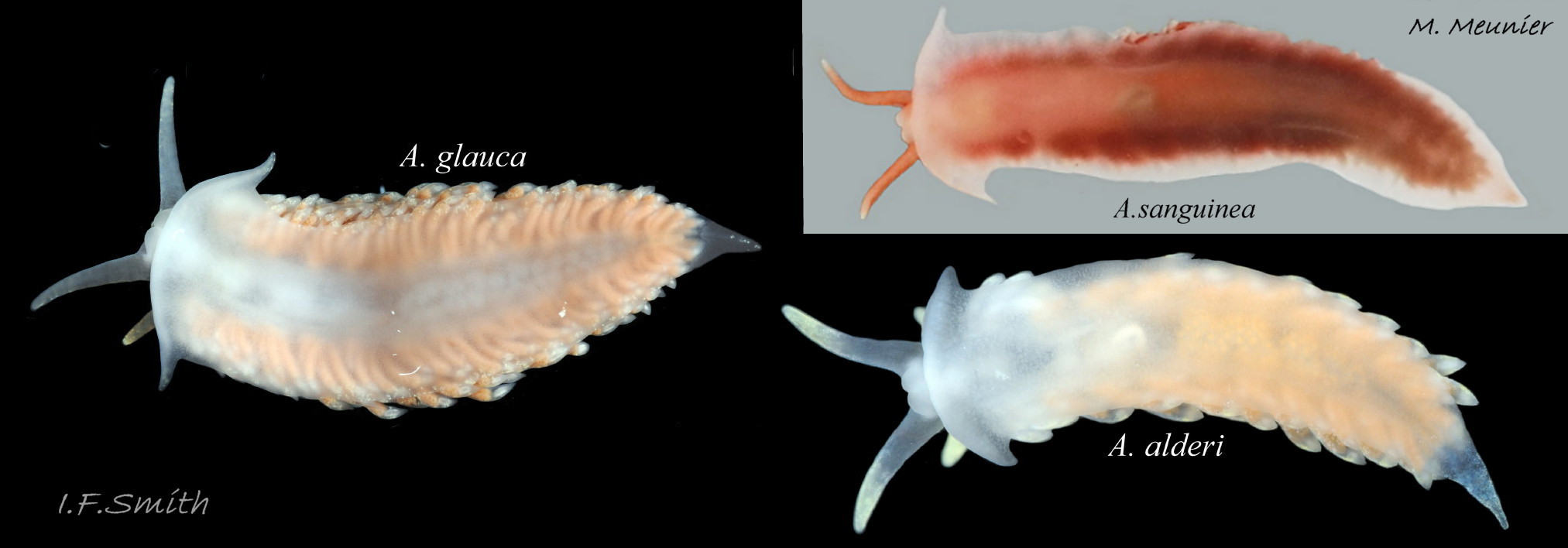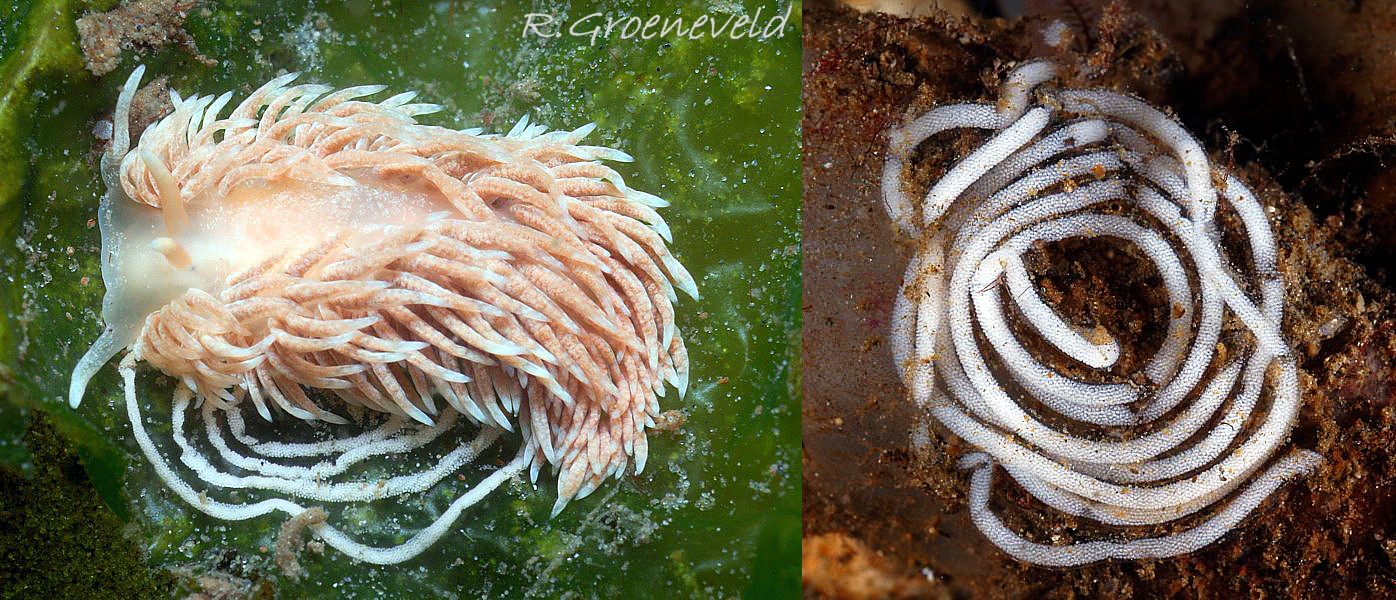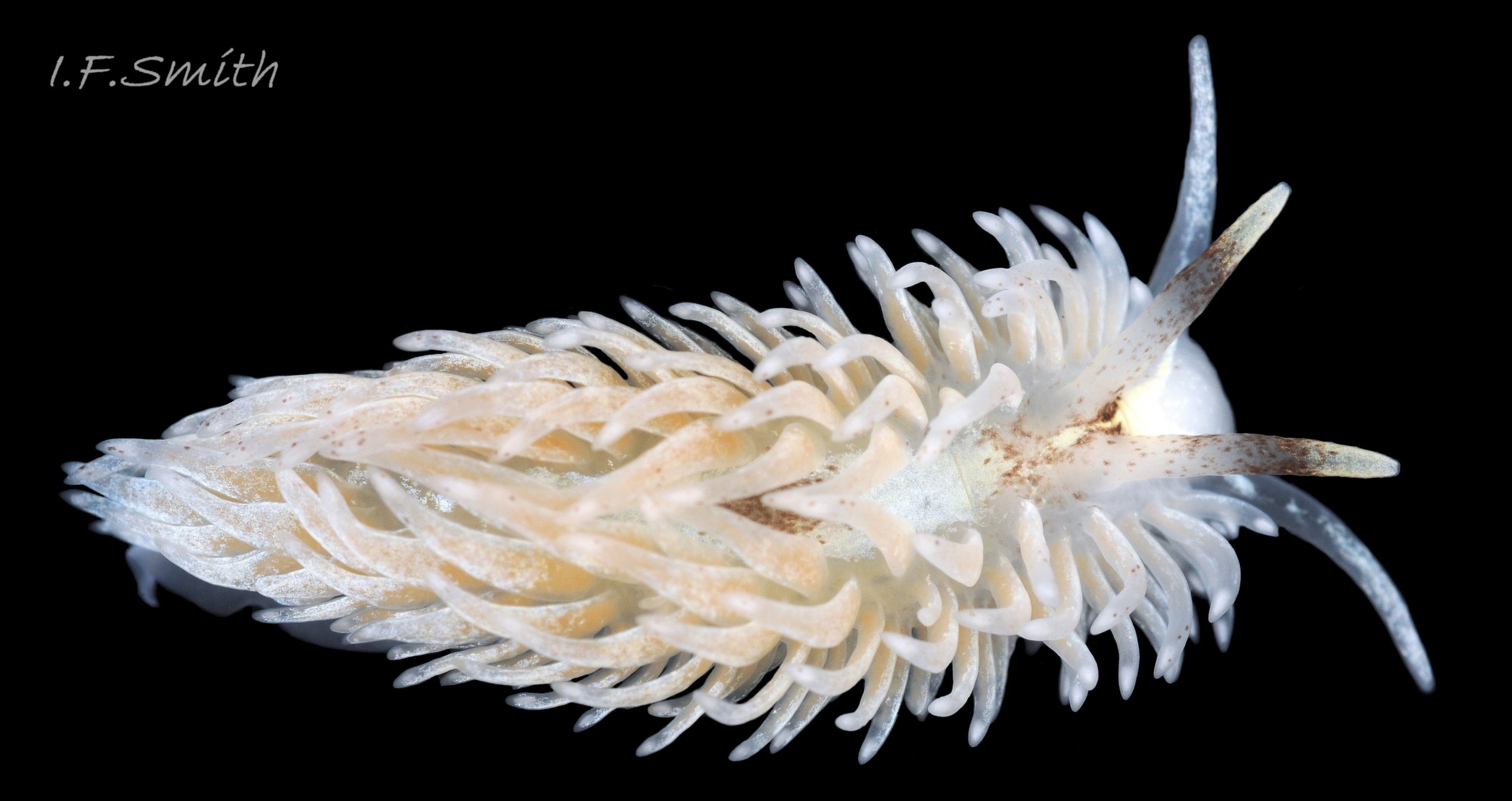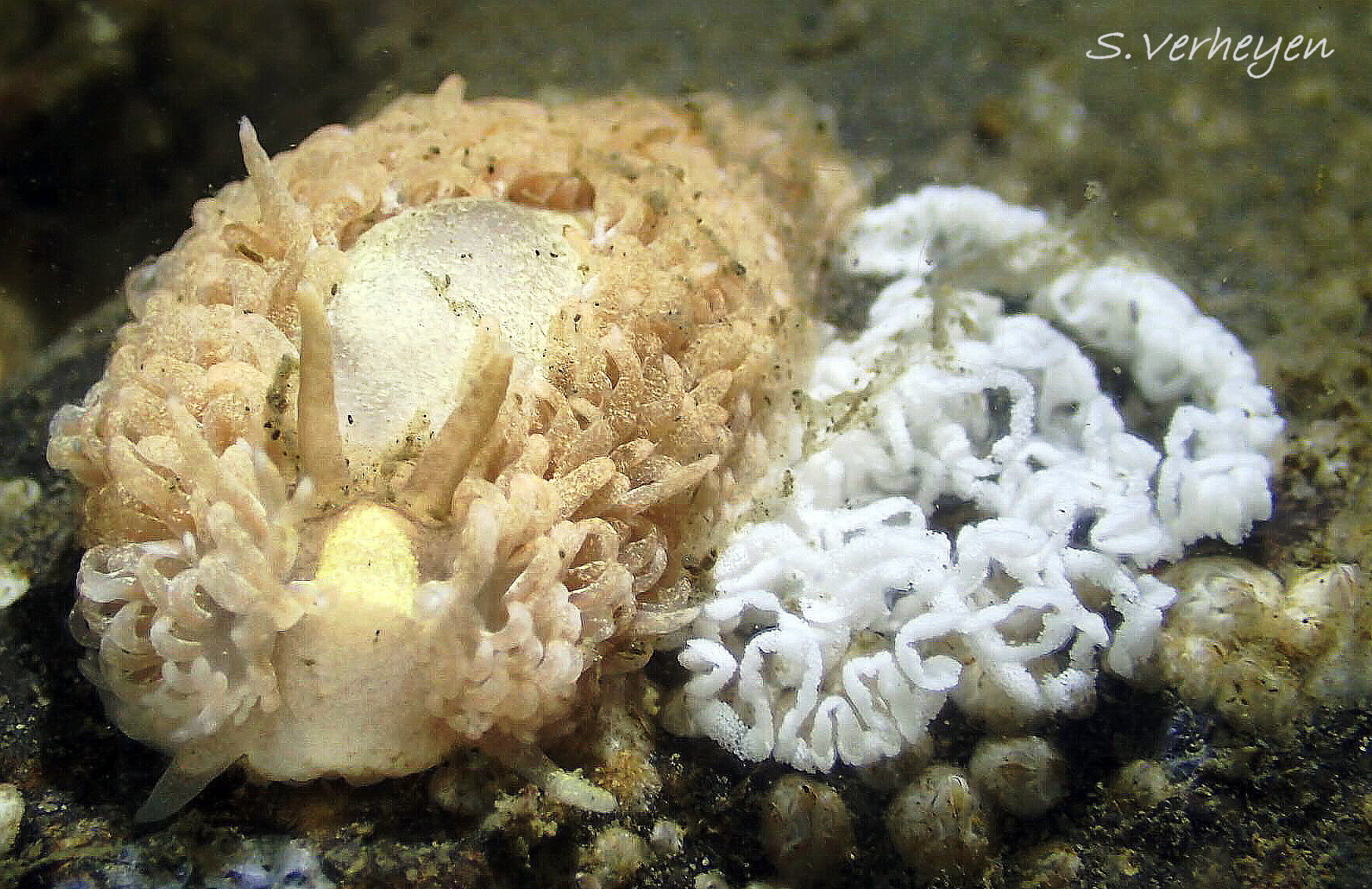Click image to enlarge with full caption. Main text below slider.
Aeolidiella sanguinea (Norman, 1877)
Synonyms: Eolis sanguinea Norman, 1877.
Current taxonomy: World Register of Marine Species www.marinespecies.org/aphia.php?p=taxdetails&id=138714
GLOSSARY BELOW
Description
The slender, sinuous body grows up to 46 mm long (Thompson & Brown, 1984). It is translucent, tinted dark blood red 01 Aeolidiella sanguinea to orange-red 02 Aeolidiella sanguinea and lacks any opaque pigment marks. The red tinting mostly, or entirely, obscures the internal viscera 03 Aeolidiella sanguinea .
The cerata are arranged in about fifteen transverse rows of five or six on each side of the body. There is often a gap of exposed notum running most of the body length between left and right rows of cerata 04 Aeolidiella sanguinea .
Like the body, the cerata are translucent red with no surface pigment. The contents of the internal digestive gland are usually brown but their visibility varies with the intensity of the red tinting 03 Aeolidiella sanguinea . Sometimes the contents have pale mottling which can be mistaken for surface pigment tip 02 Aeolidiella sanguinea . Each ceras has, distally above the digestive gland, a large white cnidosac tinted by the reddish integument 04 Aeolidiella sanguinea . On strongly tinted specimens the cnidosac appears bright red 03 Aeolidiella sanguinea .
The cerata in the anterior row often have dark contents only in the basal section. The rest of each ceras is occupied by a large white cnidosac and pale digestive gland. If the red tinting is not intense, the general colour is whitish and may resemble the white ruff of A. alderi 04 Aeolidiella sanguinea .
The smooth, sometimes wrinkled 02 Aeolidiella sanguinea , translucent rhinophores are coloured as the body except for a distinct white apical zone 03 Aeolidiella sanguinea & 05 Aeolidiella sanguinea.
The head is coloured as the body but is sometimes paler 01 Aeolidiella sanguinea , and the oral tentacles are usually paler 02 Aeolidiella sanguinea . Internal eyes are usually visible at the posterior base of the rhinophores, unless hidden by the tilt of a rhinophore 06 Aeolidiella sanguinea . The internal, opaque white internal jaw and buccal mass are occasionally faintly visible through the red tinting 05 Aeolidiella sanguinea. The distance between oral tentacles at their base is about equal to thickness of a single tentacle base 05 Aeolidiella sanguinea.
The narrow foot is usually concealed by overhanging cerata. When at its widest extension it may be twice as wide as the body 07 Aeolidiella sanguinea . It has a pointed posterior which sometimes protrudes a short distance beyond the cerata 01 Aeolidiella sanguinea . The convex anterior continues into short propodial tentacles which often bend forwards at the tip resulting in a sigmoid foot anterior 06 Aeolidiella sanguinea . The sole is usually transparent colourless showing the red of the cerata above when viewed ventrally 07 Aeolidiella sanguinea . The dorsal surface of the foot has no opaque pigment marks or flecks 05 Aeolidiella sanguinea.
Key identification features
Identification should be made with more than one feature as there is some interspecific overlap. For example, a whitish ruff of anterior cerata can sometimes be found on all three Aeolidiella species, though it is usually most fully developed on A. alderi. In some cases molecular sequencing may be required for certainty.
Aeolidiella sanguinea (Norman, 1877)
1) Maximum length 46 mm (Thompson & Brown, 1984). Slender sinuous body 02 Aeolidiella sanguinea is more slender than A. glauca and A. alderi 08 Aeolidiella sanguinea.
2) From above, internal eyes usually visible through translucent body unless hidden by tilt of rhinophore 06 Aeolidiella sanguinea.
3) All cerata have a large white cnidosac variably tinted by the orange to red surface of the cerata 03 Aeolidiella sanguinea . Front row often has dark contents only in base of digestive gland. Rest of cerata with white cnidosac and pale digestive gland may resemble white ruff of A. alderi if red tinting not intense 04 Aeolidiella sanguinea .
4) No opaque flecks on notum 03 Aeolidiella sanguinea .
5) Distance between oral tentacles about same as thickness of single tentacle base 05 Aeolidiella sanguinea.
6) Anterior edge of foot often sigmoid with short propodial tentacles curved forward at tip 06 Aeolidiella sanguinea .
7) No surface pigment on dorsal periphery of foot 05 Aeolidiella sanguinea, oral tentacles or cerata, but rhinophores have distinctly demarcated white tips 03 Aeolidiella sanguinea & 05 Aeolidiella sanguinea.
8) Body, rhinophores and cerata are translucent red, orange or yellow.
9) Spawn; a plain spiral line 09 Aeolidiella sanguinea .
10) A southern species which extends north to the south and west coasts of Britain and Ireland.
Similar species
Aeolidiella alderi (Cocks, 1852)
10 Aeolidiella sanguinea.
1) Maximum length 37 mm (Thompson & Brown, 1984). When extended, fairly robust but more slender than Aeolidia papillosa, A. filomenae and Aeolidiella glauca. Usually straighter than the more slender, sinuous A. sanguinea.
2) From above, internal eyes usually visible through translucent body unless hidden by tilt of rhinophore.
3) Front row of cerata makes a white ruff with white zone in each ceras usually 50% or more of length.
4) No opaque flecks on dorsum.5) Distance between oral tentacles about same as thickness of single tentacle base .
6) Anterior edge of foot a smooth crescent terminating in short triangular propodial tentacles which do not usually curve forward at the tip .
7) White or yellow pigment distally on rhinophores, oral tentacles and cerata, but no white pigment stipple on dorsal periphery of foot.
8) Body translucent white 11 Aeolidiella sanguinea. Some tinted yellowish or reddish 12 Aeolidiella sanguinea.
9) Spawn is a deeply sinuous line arranged loosely in a disc 13 Aeolidiella sanguinea
10) Occurs from Mediterranean to south and west Ireland and to south and west Britain as far north as Anglesey.
Aeolidiella glauca
14 Aeolidiella sanguinea & 15 Aeolidiella sanguinea
1) Maximum length 40 mm (Thompson & Brown, 1984). Body broad in comparison with A. sanguinea and A. alderi . Often, overall pinkish appearance from cerata, especially when viewed through translucent foot.
2) From above, internal eyes usually visible through translucent body.
3) Anterior cerata may be white and resemble the more fully developed white ruff on A. alderi .
4) Anterior half of body copiously speckled with pale opaque pigment fig.
5) Distance between oral tentacles about same as thickness of single tentacle base.
6) Anterior edge of foot has short propodial tentacles which may curve forwards at the tip.
7) White pigment stipple on dorsal periphery of foot, oral tentacles, cerata and, distally, on rhinophores.
8) Body translucent white, anterior often translucent orange.
9) Spawn, a plain non-sinuous spiral line 16 Aeolidiella sanguinea ; white contents divided into sections by clear breaks; ova small so width of spawn line 5 or 6 times diameter of one ovum.
10) A northern species which extends south to the south coast of Britain and possibly to France.
Aeolidia papillosa (Linnaeus, 1761) 17 Aeolidiella sanguinea.
1) Maximum length120 mm (Thompson & Brown, 1984). Body broader than Aeolidiella sanguinea.
2) Internal eyes not, or barely, visible through opaque pigment.
3) Dull whitish cnidosac visible if not obscured by white apical pigment.
4) Much opaque pigment on dorsum.
5) Distance between oral tentacles about three times thickness of tentacle base.
6) Anterior edge of foot a smooth crescent terminating in short triangular propodial tentacles.
7) Much pigment on rhinophores and cerata. Often dark and whitish pigment stipple on dorsal periphery of foot.
8) Most of body, rhinophores and cerata not translucent.
9) Spawn; large convoluted ribbon, standing upright in water, deposited in spiral 18 Aeolidiella sanguinea.
Aeolidia filomenae Kienberger, Carmona, Pola, Padula, Gosliner & Cervera, 2016 19 Aeolidiella sanguinea.
1) Maximum length at least 70 mm. Body broader than Aeolidiella sanguinea.
2) Internal eyes sometimes faintly visible in light specimens.
3) Apices of cerata are white, often revealing large white cnidosacs.
4) Dorsum white or pale colour with opaque white or brown flecks which may concentrate locally into dense brown markings.
5) Distance between oral tentacles about three times thickness of tentacle base.
6) Anterior edge of foot a smooth crescent terminating in short triangular propodial tentacles.
7) Rhinophores and cerata are translucent with varying amounts of opaque white and brown freckling. Usually no pigment stipple on dorsal surface of foot.
8) Some parts of body and cerata may be translucent.
9) Spawn; large convoluted ribbon, standing upright in water, deposited in spiral 20 Aeolidiella sanguinea
1) Maximum length 46 mm (Thompson & Brown, 1984). Slender sinuous body 02 Aeolidiella sanguinea is more slender than A. glauca and A. alderi 08 Aeolidiella sanguinea.
2) From above, internal eyes usually visible through translucent body unless hidden by tilt of rhinophore 06 Aeolidiella sanguinea.
3) All cerata have a large white cnidosac variably tinted by the orange to red surface of the cerata 03 Aeolidiella sanguinea . Front row often has dark contents only in base of digestive gland. Rest of cerata with white cnidosac and pale digestive gland may resemble white ruff of A. alderi if red tinting not intense 04 Aeolidiella sanguinea .
4) No opaque flecks on notum 03 Aeolidiella sanguinea .
5) Distance between oral tentacles about same as thickness of single tentacle base 05 Aeolidiella sanguinea.
6) Anterior edge of foot often sigmoid with short propodial tentacles curved forward at tip 06 Aeolidiella sanguinea .
7) No surface pigment on dorsal periphery of foot 05 Aeolidiella sanguinea, oral tentacles or cerata, but rhinophores have distinctly demarcated white tips 03 Aeolidiella sanguinea & 05 Aeolidiella sanguinea.
8) Body, rhinophores and cerata are translucent red, orange or yellow.
9) Spawn; a plain spiral line 09 Aeolidiella sanguinea .
10) A southern species which extends north to the south and west coasts of Britain and Ireland.
Habits and ecology
A. sanguinea lives sublittorally and, occasionally, at low water spring tide at sheltered sites. Thompson & Brown, (1984) list its Actiniaria prey 21 Aeolidiella sanguinea as Sagartiogeton undata Müller, Cylista troglodytes (Price in Johnston, 1847) and C. elegans (Dalyell, 1848) , Cereus pedunculatus (Pennant, 1777), Diadumene cinctaStephenson, 1925 and Aiptasis couchii Gosse, 1858. Like other nudibranchs, A. sanguinea is a simultaneous hermaphrodite. Spawn is deposited in a non-sinuous spiral line 09 Aeolidiella sanguinea . Veliger larvae hatch from the spawn and drift as plankton before settling on the sea floor and transforming into adults.
1) Maximum length 46 mm (Thompson & Brown, 1984). Slender sinuous body 02 Aeolidiella sanguinea is more slender than A. glauca and A. alderiflic.kr/p/2o5aL7h .
2) From above, internal eyes usually visible through translucent body unless hidden by tilt of rhinophore 06 Aeolidiella sanguinea.
3) All cerata have a large white cnidosac variably tinted by the orange to red surface of the cerata 03 Aeolidiella sanguinea . Front row often has dark contents only in base of digestive gland. Rest of cerata with white cnidosac and pale digestive gland may resemble white ruff of A. alderi if red tinting not intense 04 Aeolidiella sanguinea .
4) No opaque flecks on notum 03 Aeolidiella sanguinea .
5) Distance between oral tentacles about same as thickness of single tentacle base 05 Aeolidiella sanguinea.
6) Anterior edge of foot often sigmoid with short propodial tentacles curved forward at tip 06 Aeolidiella sanguinea .
7) No surface pigment on dorsal periphery of foot 05 Aeolidiella sanguinea, oral tentacles or cerata, but rhinophores have distinctly demarcated white tips 03 Aeolidiella sanguinea & 05 Aeolidiella sanguinea.
8) Body, rhinophores and cerata are translucent red, orange or yellow.
9) Spawn; a plain spiral line 09 Aeolidiella sanguinea .
10) A southern species which extends north to the south and west coasts of Britain and Ireland.
Distribution and status
A. sanguinea is a southern species extending north from Atlantic Iberia as far as the south and west coasts of Britain and Ireland where it is the rarest and least recorded of the three occurring Aeolidiella species. GBIF map www.gbif.org/species/2291948UK map, NBN species.nbnatlas.org/species/NBNSYS0000173624iNaturalist map www.inaturalist.org/observations?taxon_id=492401 .Uncertainty about identifications of Aeolidiella records lacking the support of clear images make its distribution uncertain. Even some records with images lack certainty as A. alderi sometimes has its translucent body tinted red or orange 12 Aeolidiella sanguinea . Records from the North Sea require convincing images for confirmation. No Mediterranean records of it are shown on GBIF or iNaturalist and it is not listed for the Adriatic in Prkić et al. (2018), so it may be absent from the Mediterranean.
1) Maximum length 46 mm (Thompson & Brown, 1984). Slender sinuous body 02 Aeolidiella sanguinea is more slender than A. glauca and A. alderi 08 Aeolidiella sanguinea.
2) From above, internal eyes usually visible through translucent body unless hidden by tilt of rhinophore 06 Aeolidiella sanguinea.
3) All cerata have a large white cnidosac variably tinted by the orange to red surface of the cerata 03 Aeolidiella sanguinea . Front row often has dark contents only in base of digestive gland. Rest of cerata with white cnidosac and pale digestive gland may resemble white ruff of A. alderi if red tinting not intense 04 Aeolidiella sanguinea .
4) No opaque flecks on notum 03 Aeolidiella sanguinea .
5) Distance between oral tentacles about same as thickness of single tentacle base 05 Aeolidiella sanguinea.
6) Anterior edge of foot often sigmoid with short propodial tentacles curved forward at tip 06 Aeolidiella sanguinea .
7) No surface pigment on dorsal periphery of foot 05 Aeolidiella sanguinea, oral tentacles or cerata, but rhinophores have distinctly demarcated white tips 03 Aeolidiella sanguinea & 05 Aeolidiella sanguinea.
8) Body, rhinophores and cerata are translucent red, orange or yellow.
9) Spawn; a plain spiral line 09 Aeolidiella sanguinea .
10) A southern species which extends north to the south and west coasts of Britain and Ireland.
Acknowledgements
For use of images I thank Guy Freeman, Rokus Groeneveld, Éabha Hughes, Ben James MARINEPHOTOS@nature.scot, Sylvain Le Bris, João Pedro Silva, Malcolm Storey, Stefan Verheyen, and Mathias Meunier and Lou Valence. I thank Simon Taylor for specimens.
1) Maximum length 46 mm (Thompson & Brown, 1984). Slender sinuous body 02 Aeolidiella sanguinea is more slender than A. glauca and A. alderiflic.kr/p/2o5aL7h .
2) From above, internal eyes usually visible through translucent body unless hidden by tilt of rhinophore 06 Aeolidiella sanguinea.
3) All cerata have a large white cnidosac variably tinted by the orange to red surface of the cerata 03 Aeolidiella sanguinea . Front row often has dark contents only in base of digestive gland. Rest of cerata with white cnidosac and pale digestive gland may resemble white ruff of A. alderi if red tinting not intense 04 Aeolidiella sanguinea .
4) No opaque flecks on notum 03 Aeolidiella sanguinea .
5) Distance between oral tentacles about same as thickness of single tentacle base 05 Aeolidiella sanguinea.
6) Anterior edge of foot often sigmoid with short propodial tentacles curved forward at tip 06 Aeolidiella sanguinea .
7) No surface pigment on dorsal periphery of foot 05 Aeolidiella sanguinea, oral tentacles or cerata, but rhinophores have distinctly demarcated white tips 03 Aeolidiella sanguinea & 05 Aeolidiella sanguinea.
8) Body, rhinophores and cerata are translucent red, orange or yellow.
9) Spawn; a plain spiral line 09 Aeolidiella sanguinea .
10) A southern species which extends north to the south and west coasts of Britain and Ireland.
References and links
Groeneveld, R. & Reijs, S. (accessed 12 November 2022) Zeenaaktslakken, Nudibranchia. www.diverosa.com/FF_NL/ff_zeenaaktslakken.htm Prkić, J., Petani, A., Iglić, Đ. and Lanča, L. 2018. Opisthobranchs of the Adriatic Sea. Photographic atlas and list of Croatian Species. Croatia. Storey, M. W. BioImages, virtual fieldguide UK www.bioimages.org.uk/ (accessed 30 November 2022) Tardy, J. 1969. Étude systématique et biologique sur trois espèces d’Aeolidielles des côtes européennes (Gastéropodes Nudibranches). Bull. Inst. Oceanogr. Monaco68: 1 – 40. Thompson, T.E. & Brown, G.H. 1984. Biology of opisthobranch molluscs 2. London, Ray Society.
1) Maximum length 46 mm (Thompson & Brown, 1984). Slender sinuous body 02 Aeolidiella sanguinea is more slender than A. glauca and A. alderi 08 Aeolidiella sanguinea.
2) From above, internal eyes usually visible through translucent body unless hidden by tilt of rhinophore 06 Aeolidiella sanguinea.
3) All cerata have a large white cnidosac variably tinted by the orange to red surface of the cerata 03 Aeolidiella sanguinea . Front row often has dark contents only in base of digestive gland. Rest of cerata with white cnidosac and pale digestive gland may resemble white ruff of A. alderi if red tinting not intense 04 Aeolidiella sanguinea .
4) No opaque flecks on notum 03 Aeolidiella sanguinea .
5) Distance between oral tentacles about same as thickness of single tentacle base 05 Aeolidiella sanguinea.
6) Anterior edge of foot often sigmoid with short propodial tentacles curved forward at tip 06 Aeolidiella sanguinea .
7) No surface pigment on dorsal periphery of foot 05 Aeolidiella sanguinea, oral tentacles or cerata, but rhinophores have distinctly demarcated white tips 03 Aeolidiella sanguinea & 05 Aeolidiella sanguinea.
8) Body, rhinophores and cerata are translucent red, orange or yellow.
9) Spawn; a plain spiral line 09 Aeolidiella sanguinea .
10) A southern species which extends north to the south and west coasts of Britain and Ireland.
Glossary
cerata = (sing. ceras, adj. ceratal) lobes on notum of some nudibranchs.
Cnidaria = hydroids, jellyfish, sea anemones etc. which possess cnidocytes.
cnidocytes = explosive stinging cells of Cnidaria. en.wikipedia.org/wiki/Cnidocyte
cnidosac = storage capsule at tips of cerata of Aeolidiidae for ingested cnidocytes.
digestive gland = large organ in gastropods which acts like the liver and pancreas in mammals to absorb food.
distal = away from centre of body or from point of attachment.
hermaphrodite, simultaneous = individual acts as both male and female at the same time with similar partner.
integument = an enveloping layer, such as a skin, membrane or cuticle, of an organism or one of its parts.
notum = (of sea slugs) the dorsal surface of the body; the back.
propodial tentacles = tentacular, lateral extensions on anterior of the foot.
rhinophore = chemo-receptor tentacle; many sea slugs have a pair on top of the head.
veliger = shelled larva which moves by action of cilia on a velum (bilobed flap). Stage may be passed in plankton or within liquid-filled egg-capsule.
